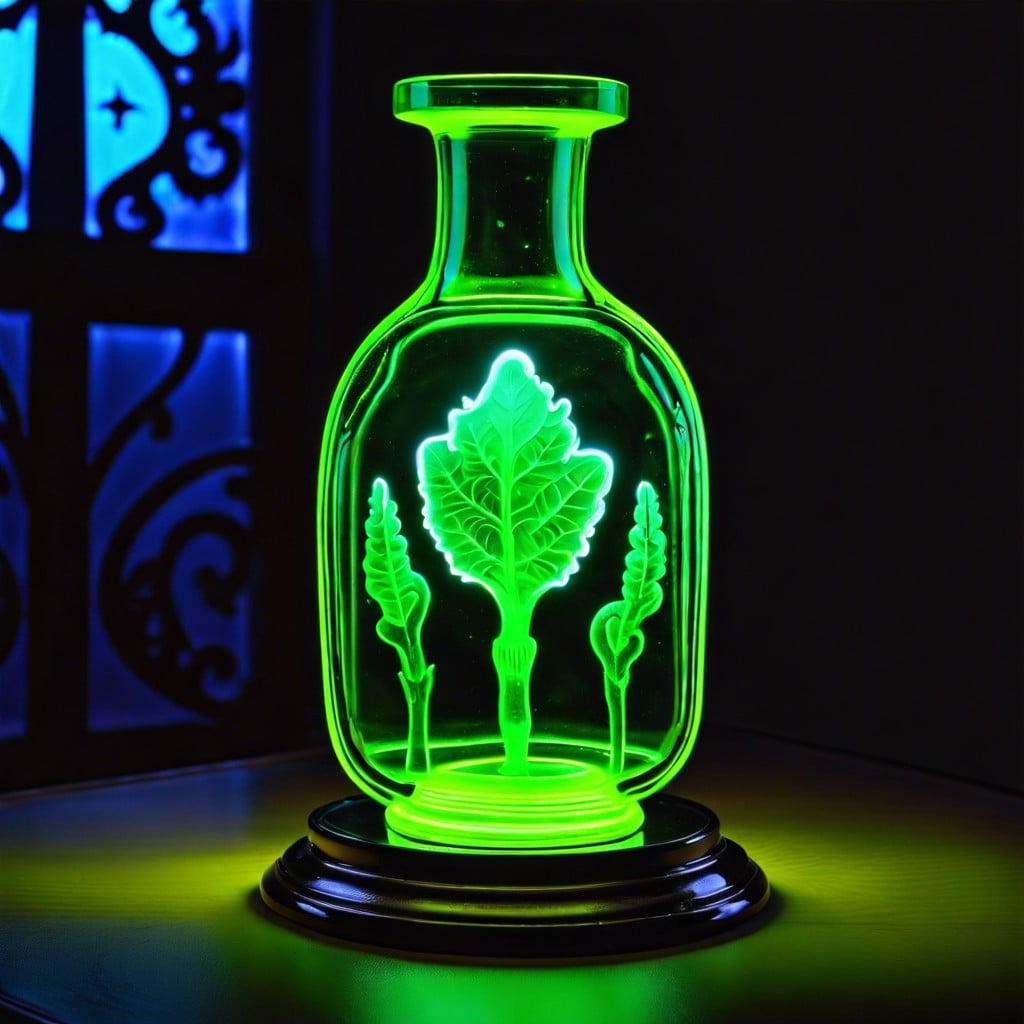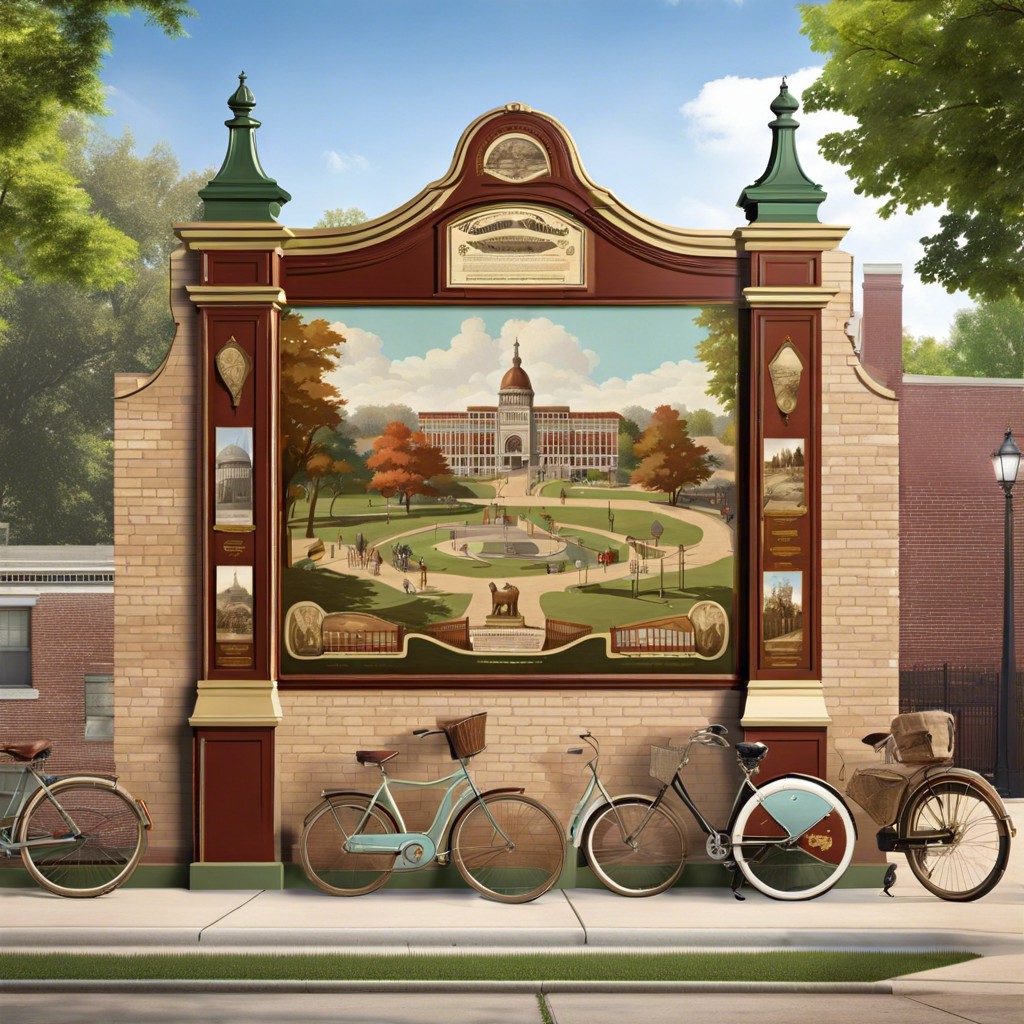Last updated on
Explore the vibrant world of antique collecting as we delve into uranium glass because its unique, radiant glow attracts enthusiasts globally.
Key takeaways:
- Uranium glass contains uranium oxide, giving it a distinct fluorescent color.
- It gained popularity in the late 19th and early 20th centuries.
- Uranium glass comes in various colors, with Vaseline glass being the most common.
- Uranium glass is no longer widely produced commercially.
- It can be identified by its unique glow under UV light.
Definition of Uranium Glass

Uranium glass is a form of glassware that contains uranium oxide, typically in amounts ranging from as little as 0.1% to over 20%, which imparts a distinct fluorescent green or yellow color. The characteristic glow of uranium glass under UV light is due to the uranium content.
Despite its radioactive content, the radioactivity levels are generally considered too low to pose a health threat, making the glass safe for handling and use in household items. Discovered in the 1830s, this type of glass gained popularity in the late 19th and early 20th centuries and remains a curiosity and collectible item today.
The unique color and luminescence of uranium glass are prized by collectors and can be a conversation piece in any setting.
Historical Background of Uranium Glass

The development of uranium glass dates back to the 1830s, largely credited to Josef Riedel, known as the ‘Glass King of the Iser Mountains’ in Bohemia. Initially, the unique tones of green and yellow achieved by adding uranium dioxide to glass mixtures were not only a stylistic choice but also a byproduct of experimentation.
During the late 19th and early 20th century, the material gained popularity, especially in the Art Nouveau period, for its distinctive appearance and the mesmerizing glow it exhibited under UV light.
Mass production began in the 1840s, and while the use of uranium in glassmaking dwindled during the Cold War era due to its utilization in nuclear arms, it saw a resurgence in the 1950s. Antiques and collectibles from the Victorian era to the Depression era in the United States are testament to its enduring appeal.
However, considering the varying levels of uranium used through different periods, each piece offers a unique glimpse into the evolving techniques and societal trends of the time.
Appearance of Uranium Glass, Including Vaseline and Other Colors
Uranium glass possesses a distinct fluorescence under ultraviolet light due to its uranium content, typically ranging from 0.1% to 2%. While some pieces may exhibit a subtle green tint under natural lighting, the glass truly comes to life with a bright green glow when exposed to UV light.
The most common and iconic variant is Vaseline glass, aptly named for its resemblance to petroleum jelly in both color and consistency. This type often exhibits a yellow-green hue and is more transparent. However, the range of colors extends across the spectrum, including more opaque forms such as custard glass, which has a creamy, yellow appearance, and Burmese glass, featuring gradients of pink and yellow.
The intensity and shade of green or yellow can vary greatly, affected by the concentration of uranium and the presence of other coloring agents.
Fabrication and Modern Usage of Uranium Glass
Uranium glass is crafted by incorporating small amounts of uranium oxide into the glass mix before melting. This addition gives the glass its characteristic neon green or yellow color. Ideally, the glass is melted at temperatures of about 1,200 to 1,400 degrees Celsius and then molded into desired shapes or blown by artisans.
In contemporary settings, uranium glass is no longer widely produced commercially due to concerns over the use of uranium. However, its unique glow under ultraviolet light has made it a favorite among collectors and artists. It’s often used to create striking artwork or decorative pieces that illuminate with a surreal glow in the presence of UV light. Some bespoke glassmakers and hobbyists continue to produce uranium glass items on a small scale, adhering to safety guidelines to ensure minimal risk.
Jewelry, marbles, beads, and figurines are common modern items made from uranium glass, cherished for their unique appearance and historical value rather than their practicality. While no longer a mainstream product, uranium glass has found a niche where its unusual and aesthetic qualities are appreciated.
Types of Items Made From Uranium Glass
Numerous decorative and utilitarian objects have historically been made from uranium glass, showcasing its distinctive glow and variety of colors. Tableware, such as plates, cups, and goblets, often featured intricate patterns that radiated under UV light. Beyond serving pieces, collectors find vases and figurines particularly captivating due to their artistic forms and reactive properties.
In the realm of personal adornment, manufacturers crafted jewelry, including beads and brooches, that exhibited a subtle luminosity by day and an otherworldly glow by night. Lampshades and light fixtures made from this material benefited from its unique ability to disperse light, creating a warm ambiance in the homes of the early to mid-20th century.
Commemorative items, like paperweights or souvenir items, also utilized uranium glass to add a novel and memorable touch. Advancements in crafting techniques allowed for the production of a wide array of mementos and novelty goods that catered to the eclectic tastes of different eras.
Health Concerns and Safe Handling Practices for Uranium Glass
While uranium glass contains a small amount of uranium, the radiation levels are generally considered low and often comparable to the natural background levels we are exposed to regularly. However, it’s prudent to exercise caution to minimize any potential risks, especially when handling these items frequently:
1. Limit prolonged exposure: If you’re working closely with uranium glass, particularly for crafting or manufacturing, wear protective gloves and limit the time spent handling the pieces.
2. Safe display: Store uranium glass behind glass cabinet doors to block any potential alpha particles, and maintain a moderate distance from living spaces where extended time is spent.
3. Washing practices: After touching uranium glass, wash your hands thoroughly as a precautionary measure, avoiding ingestion of any uranium particles that may have been left on the surface.
4. Use considerations: Avoid using uranium glass for storing or serving food and beverages since acids and liquids could potentially leach uranium from the glass.
By following these guidelines, enthusiasts can enjoy collecting and displaying uranium glass with reassurance regarding health and safety.
Identifying Genuine Uranium Glass
Determining the authenticity of uranium glass hinges on its unique characteristics. At first glance, pieces will exhibit a subtle green to yellowish hue, with variations ranging from opaque to transparent. The most definitive test involves the use of ultraviolet light; under UV exposure, authentic uranium glass will fluoresce with a distinct, vibrant green glow due to the uranium content.
For a more hands-on approach, enthusiasts may check the weight and sound of the glass. Uranium glass tends to be denser and heavier than ordinary glass, and when tapped, it produces a ringing sound distinct from the dull thud of non-uranium counterparts.
Vintage patterns and designs can also serve as indicators, as certain periods favored the production of uranium glass, especially the late 19th and early 20th centuries. Examining the wear and patina can offer clues about the glass’s age, supporting its authenticity.
Finally, consult a trusted expert or reach out to collectors’ groups for validation, as experience often offers insight into the subtleties of authentic pieces. With these tips, collectors can cultivate the skill of distinguishing genuine uranium glass from imitations.
Value and Collectibility of Uranium Glass
Uranium glass, often regarded as a lesser-known gem in the world of collectibles, has gained a reputation for its unique glow and historical significance. Its value can vary greatly depending on several factors. Rarity plays a significant role; pieces from the late 1800s to the early 20th century typically command higher prices due to their age and limited availability.
Condition is also crucial, with pristine items free of chips or cracks being more sought after. The intensity of color, which is more vibrant in older pieces due to higher uranium content, also affects desirability. Additionally, the intricacy of design and the reputation of the manufacturer contribute to a piece’s collectibility. Collectors may pay a premium for complex patterns or pieces from renowned glassworks like Fenton or Cambridge.
Market trends and current demand can shift values over time, making some once common items suddenly popular and valuable. It’s advisable for collectors to research recent auction results and consult with antique glass experts to determine the current worth of their uranium glass items.
Pertinent Regulations On Uranium Glass
Given its radioactive content, the production and sale of uranium glass are subject to specific regulations to ensure public safety. In the United States, the Nuclear Regulatory Commission (NRC) oversees the distribution of materials containing uranium. Regulations ensure that the amount of uranium in glassware remains at levels that are considered safe for handling and use by the general public.
In the European Union, similar measures are in place. The Euratom Treaty establishes standards for radiation protection, which apply to consumer goods like uranium glass. Importantly, before purchasing such items, especially from international sources, it’s advisable to check with local import regulations as certain countries may have more restrictive measures.
Makers and sellers of uranium glassware must conform to these regulations and often, the glass is tested for radioactivity to assure it falls below a specific threshold. It’s crucial for collectors and handlers to be aware that despite its novelty and collectibility, uranium glass is subject to these regulations for health and safety reasons.
Future of Uranium Glass Production
The future production of uranium glass hinges on a delicate balance between nostalgic appeal and regulatory constraints. As awareness of radioactive materials grows, stringent safety protocols influence both the creation and distribution of uranium-containing products. Nevertheless, artists and manufacturers continue to explore safe levels of uranium to perpetuate the craft without jeopardizing public health.
Advances in manufacturing technologies could see the development of new, safer luminescent materials, potentially reducing the use of uranium. Meanwhile, the glassblowing community maintains interest in traditional techniques, ensuring a niche market. Environmental and health concerns will ultimately shape the scale of future production, with potential for increased oversight in the sourcing of materials.
Despite these uncertainties, the distinct glow of uranium glass remains a cherished characteristic that collectors and enthusiasts are likely to preserve into the future.




